使用 Django 的电子商务网站
该项目涉及开发一个虚拟网站“电子商务网站” 。它为用户提供了可以在商店中购买的各种产品的列表。为方便网上购物,为用户提供了购物车。选好商品后,发送至订单确认流程。该系统是使用 Python 的 Web 框架 Django 实现的。开发一个电子商务网站,需要学习和了解很多技术。
范围:项目范围将限于电子商务网站的部分功能。它将显示产品,客户可以选择目录和选择产品,并且可以从他们的购物车中删除产品,指定每个项目的数量。选定的物品将被收集在购物车中。结账时,卡上的商品将作为订单显示。客户可以为购物车中的商品付款以完成订单。这个项目有很大的未来空间。该项目还通过使用登录 ID 和密码提供安全性,以便未经授权的用户无法访问您的帐户。只有具有适当访问权限的授权人员才能访问该软件。
项目中用到的技术:
Django 框架和 SQLite 数据库,它默认随 Django 一起提供。
构建项目所需的技能:
了解Python和 Django 框架的基础知识。
ER 和用例图
客户界面:
- 顾客购买产品
- 客户更改数量
- 客户将商品添加到购物车
- 客户查看购物车
- 客户结账
- 客户发送订单
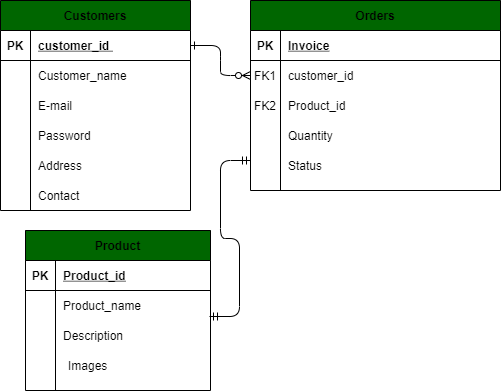
客户ER图

客户用例图
管理界面:
- 管理员登录
- 管理员插入项目
- 管理员删除项目
- 管理员修改项目
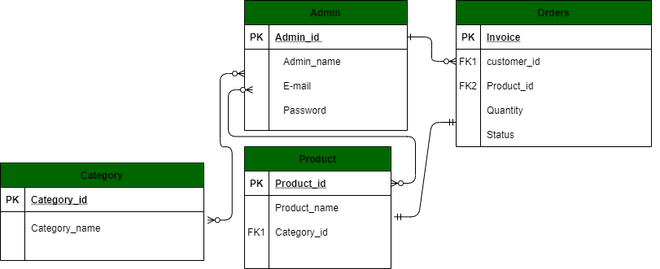
管理员的ER图

管理员的用例图
分步实施:
- 创建普通项目:打开 IDE 并通过选择 File -> New Project创建一个普通项目。
- 安装 Django:接下来,我们将从终端安装 Django 模块。我们将使用 PyCharm 集成终端来完成此任务。也可以在 windows 上使用 cmd 运行Python -m pip install django命令来安装模块
- 检查已安装的 Django 版本:要检查已安装的 Django 版本,您可以运行Python -m django -version命令,如下所示。
- 创建 Django 项目:当我们执行django-admin startproject命令时,它会在我们这里已经创建的普通项目中创建一个 Django 项目。 django-admin startproject 项目名称。
- 检查 Python3 版本: python3 –version
- 运行默认的 Django 网络服务器:- Django 内部提供了一个默认的网络服务器,我们可以在其中启动我们的应用程序。终端中的Python manage.py runserver命令。默认情况下,服务器在端口 8000 上运行。通过突出显示的 URL 访问网络服务器。
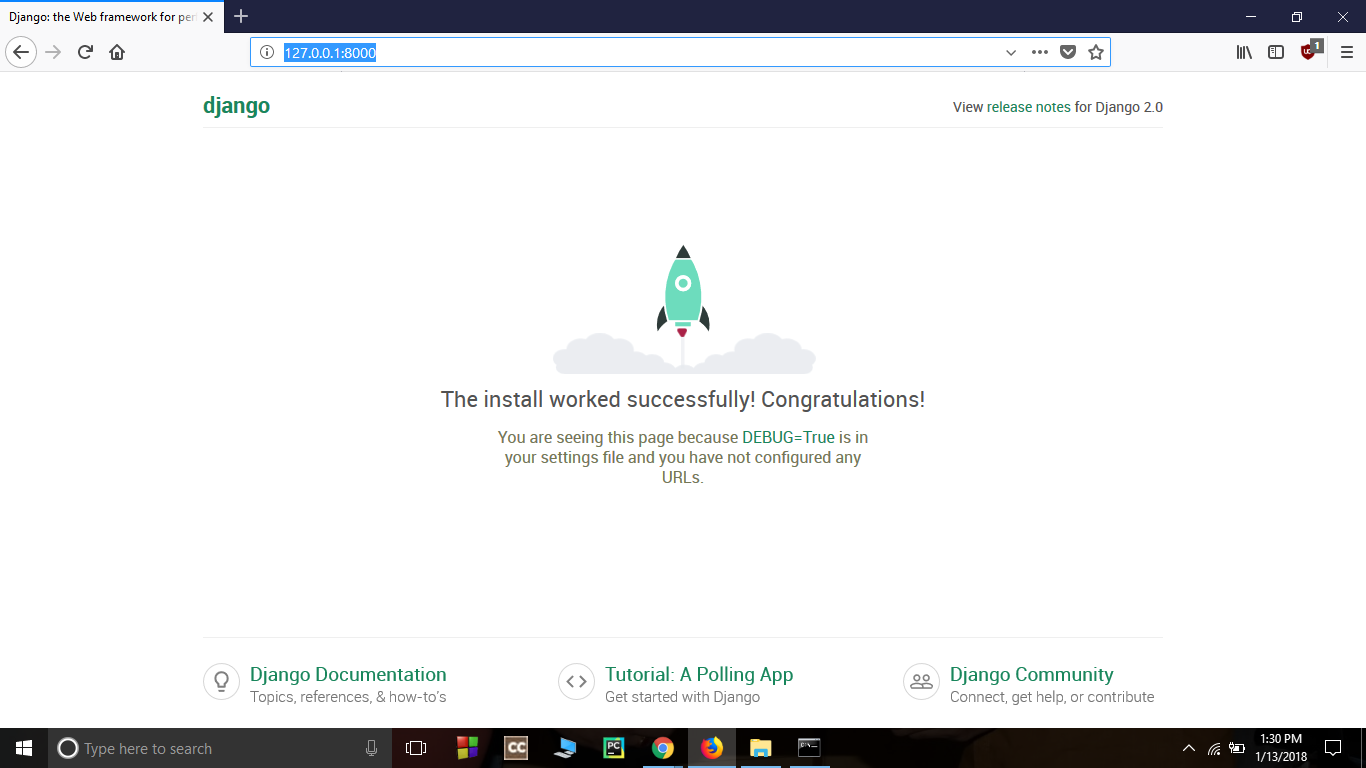
使用文本编辑器打开项目文件夹。目录结构应如下所示:
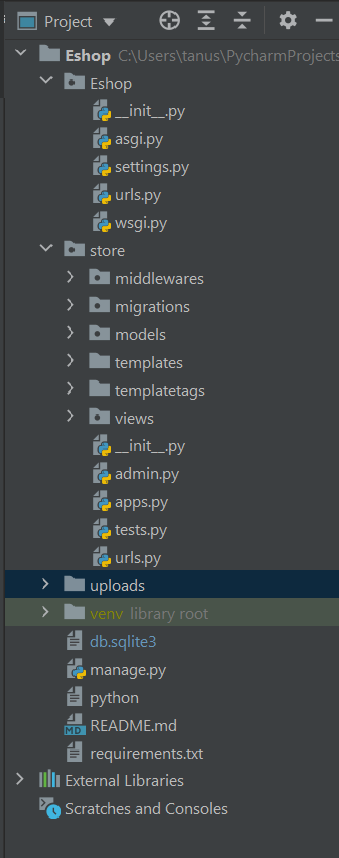
项目结构
现在在settings.py的电子商务网站中添加商店应用程序。

网址.py
此文件包含网站使用的所有 URL 模式
Python3
from django.contrib import admin
from django.urls import path, include
from django.conf.urls.static import static
from . import settings
urlpatterns = [
path('admin/', admin.site.urls),
path('', include('store.urls'))
] + static(settings.MEDIA_URL, document_root=settings.MEDIA_ROOT)Python3
from django.db import models
class Category(models.Model):
name = models.CharField(max_length=50)
@staticmethod
def get_all_categories():
return Category.objects.all()
def __str__(self):
return self.namePython3
from django.db import models
class Customer(models.Model):
first_name = models.CharField(max_length=50)
last_name = models.CharField(max_length=50)
phone = models.CharField(max_length=10)
email = models.EmailField()
password = models.CharField(max_length=100)
# to save the data
def register(self):
self.save()
@staticmethod
def get_customer_by_email(email):
try:
return Customer.objects.get(email=email)
except:
return False
def isExists(self):
if Customer.objects.filter(email=self.email):
return True
return FalsePython3
from django.db import models
from .category import Category
class Products(models.Model):
name = models.CharField(max_length=60)
price = models.IntegerField(default=0)
category = models.ForeignKey(Category, on_delete=models.CASCADE, default=1)
description = models.CharField(
max_length=250, default='', blank=True, null=True)
image = models.ImageField(upload_to='uploads/products/')
@staticmethod
def get_products_by_id(ids):
return Products.objects.filter(id__in=ids)
@staticmethod
def get_all_products():
return Products.objects.all()
@staticmethod
def get_all_products_by_categoryid(category_id):
if category_id:
return Products.objects.filter(category=category_id)
else:
return Products.get_all_products()Python
from django.db import models
from .product import Products
from .customer import Customer
import datetime
class Order(models.Model):
product = models.ForeignKey(Products,
on_delete=models.CASCADE)
customer = models.ForeignKey(Customer,
on_delete=models.CASCADE)
quantity = models.IntegerField(default=1)
price = models.IntegerField()
address = models.CharField(max_length=50, default='', blank=True)
phone = models.CharField(max_length=50, default='', blank=True)
date = models.DateField(default=datetime.datetime.today)
status = models.BooleanField(default=False)
def placeOrder(self):
self.save()
@staticmethod
def get_orders_by_customer(customer_id):
return Order.objects.filter(customer=customer_id).order_by('-date')Python3
from django.contrib import admin
from django.urls import path
from .views.home import Index, store
from .views.signup import Signup
from .views.login import Login, logout
from .views.cart import Cart
from .views.checkout import CheckOut
from .views.orders import OrderView
from .middlewares.auth import auth_middleware
urlpatterns = [
path('', Index.as_view(), name='homepage'),
path('store', store, name='store'),
path('signup', Signup.as_view(), name='signup'),
path('login', Login.as_view(), name='login'),
path('logout', logout, name='logout'),
path('cart', auth_middleware(Cart.as_view()), name='cart'),
path('check-out', CheckOut.as_view(), name='checkout'),
path('orders', auth_middleware(OrderView.as_view()), name='orders'),
]Python3
from django.shortcuts import render, redirect, HttpResponseRedirect
from store.models.product import Products
from store.models.category import Category
from django.views import View
# Create your views here.
class Index(View):
def post(self, request):
product = request.POST.get('product')
remove = request.POST.get('remove')
cart = request.session.get('cart')
if cart:
quantity = cart.get(product)
if quantity:
if remove:
if quantity <= 1:
cart.pop(product)
else:
cart[product] = quantity-1
else:
cart[product] = quantity+1
else:
cart[product] = 1
else:
cart = {}
cart[product] = 1
request.session['cart'] = cart
print('cart', request.session['cart'])
return redirect('homepage')
def get(self, request):
# print()
return HttpResponseRedirect(f'/store{request.get_full_path()[1:]}')
def store(request):
cart = request.session.get('cart')
if not cart:
request.session['cart'] = {}
products = None
categories = Category.get_all_categories()
categoryID = request.GET.get('category')
if categoryID:
products = Products.get_all_products_by_categoryid(categoryID)
else:
products = Products.get_all_products()
data = {}
data['products'] = products
data['categories'] = categories
print('you are : ', request.session.get('email'))
return render(request, 'index.html', data)Python3
from django.shortcuts import render, redirect, HttpResponseRedirect
from django.contrib.auth.hashers import check_password
from store.models.customer import Customer
from django.views import View
class Login(View):
return_url = None
def get(self, request):
Login.return_url = request.GET.get('return_url')
return render(request, 'login.html')
def post(self, request):
email = request.POST.get('email')
password = request.POST.get('password')
customer = Customer.get_customer_by_email(email)
error_message = None
if customer:
flag = check_password(password, customer.password)
if flag:
request.session['customer'] = customer.id
if Login.return_url:
return HttpResponseRedirect(Login.return_url)
else:
Login.return_url = None
return redirect('homepage')
else:
error_message = 'Invalid !!'
else:
error_message = 'Invalid !!'
print(email, password)
return render(request, 'login.html', {'error': error_message})
def logout(request):
request.session.clear()
return redirect('login')Python3
from django.shortcuts import render, redirect
from django.contrib.auth.hashers import make_password
from store.models.customer import Customer
from django.views import View
class Signup (View):
def get(self, request):
return render(request, 'signup.html')
def post(self, request):
postData = request.POST
first_name = postData.get('firstname')
last_name = postData.get('lastname')
phone = postData.get('phone')
email = postData.get('email')
password = postData.get('password')
# validation
value = {
'first_name': first_name,
'last_name': last_name,
'phone': phone,
'email': email
}
error_message = None
customer = Customer(first_name=first_name,
last_name=last_name,
phone=phone,
email=email,
password=password)
error_message = self.validateCustomer(customer)
if not error_message:
print(first_name, last_name, phone, email, password)
customer.password = make_password(customer.password)
customer.register()
return redirect('homepage')
else:
data = {
'error': error_message,
'values': value
}
return render(request, 'signup.html', data)
def validateCustomer(self, customer):
error_message = None
if (not customer.first_name):
error_message = "Please Enter your First Name !!"
elif len(customer.first_name) < 3:
error_message = 'First Name must be 3 char long or more'
elif not customer.last_name:
error_message = 'Please Enter your Last Name'
elif len(customer.last_name) < 3:
error_message = 'Last Name must be 3 char long or more'
elif not customer.phone:
error_message = 'Enter your Phone Number'
elif len(customer.phone) < 10:
error_message = 'Phone Number must be 10 char Long'
elif len(customer.password) < 5:
error_message = 'Password must be 5 char long'
elif len(customer.email) < 5:
error_message = 'Email must be 5 char long'
elif customer.isExists():
error_message = 'Email Address Already Registered..'
# saving
return error_messagePython3
from django.db import models
from .product import Products
from .customer import Customer
import datetime
class Order(models.Model):
product = models.ForeignKey(Products,
on_delete=models.CASCADE)
customer = models.ForeignKey(Customer,
on_delete=models.CASCADE)
quantity = models.IntegerField(default=1)
price = models.IntegerField()
address = models.CharField(max_length=50, default='', blank=True)
phone = models.CharField(max_length=50, default='', blank=True)
date = models.DateField(default=datetime.datetime.today)
status = models.BooleanField(default=False)
def placeOrder(self):
self.save()
@staticmethod
def get_orders_by_customer(customer_id):
return Order.objects.filter(customer=customer_id).order_by('-date')Python3
from django.shortcuts import render, redirect
from django.contrib.auth.hashers import check_password
from store.models.customer import Customer
from django.views import View
from store.models.product import Products
from store.models.orders import Order
class CheckOut(View):
def post(self, request):
address = request.POST.get('address')
phone = request.POST.get('phone')
customer = request.session.get('customer')
cart = request.session.get('cart')
products = Products.get_products_by_id(list(cart.keys()))
print(address, phone, customer, cart, products)
for product in products:
print(cart.get(str(product.id)))
order = Order(customer=Customer(id=customer),
product=product,
price=product.price,
address=address,
phone=phone,
quantity=cart.get(str(product.id)))
order.save()
request.session['cart'] = {}
return redirect('cart')Python3
from django.shortcuts import render, redirect
from django.contrib.auth.hashers import check_password
from store.models.customer import Customer
from django.views import View
from store.models.product import Products
from store.models.orders import Order
from store.middlewares.auth import auth_middleware
class OrderView(View):
def get(self, request):
customer = request.session.get('customer')
orders = Order.get_orders_by_customer(customer)
print(orders)
return render(request, 'orders.html', {'orders': orders})楷模
下面的屏幕截图显示了我们需要创建的所需模型。这些模型是将存储在 SQLite 数据库中的表。
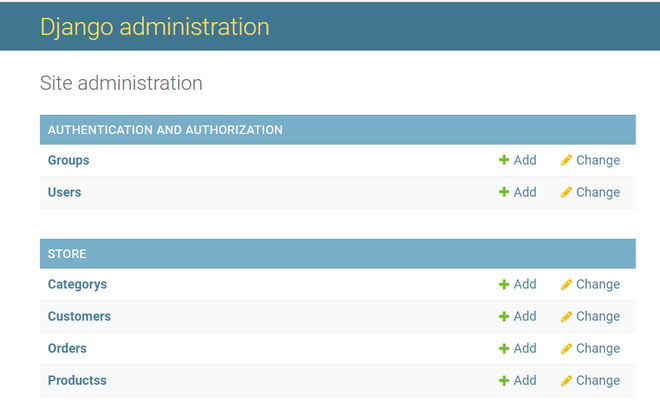
让我们看看每个模型以及每个模型所需的字段。
类别.py
蟒蛇3
from django.db import models
class Category(models.Model):
name = models.CharField(max_length=50)
@staticmethod
def get_all_categories():
return Category.objects.all()
def __str__(self):
return self.name

客户.py
蟒蛇3
from django.db import models
class Customer(models.Model):
first_name = models.CharField(max_length=50)
last_name = models.CharField(max_length=50)
phone = models.CharField(max_length=10)
email = models.EmailField()
password = models.CharField(max_length=100)
# to save the data
def register(self):
self.save()
@staticmethod
def get_customer_by_email(email):
try:
return Customer.objects.get(email=email)
except:
return False
def isExists(self):
if Customer.objects.filter(email=self.email):
return True
return False
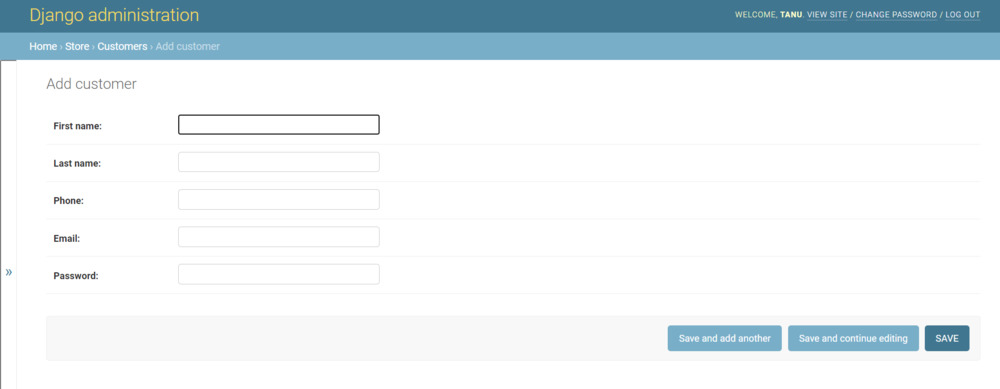
产品.py
蟒蛇3
from django.db import models
from .category import Category
class Products(models.Model):
name = models.CharField(max_length=60)
price = models.IntegerField(default=0)
category = models.ForeignKey(Category, on_delete=models.CASCADE, default=1)
description = models.CharField(
max_length=250, default='', blank=True, null=True)
image = models.ImageField(upload_to='uploads/products/')
@staticmethod
def get_products_by_id(ids):
return Products.objects.filter(id__in=ids)
@staticmethod
def get_all_products():
return Products.objects.all()
@staticmethod
def get_all_products_by_categoryid(category_id):
if category_id:
return Products.objects.filter(category=category_id)
else:
return Products.get_all_products()
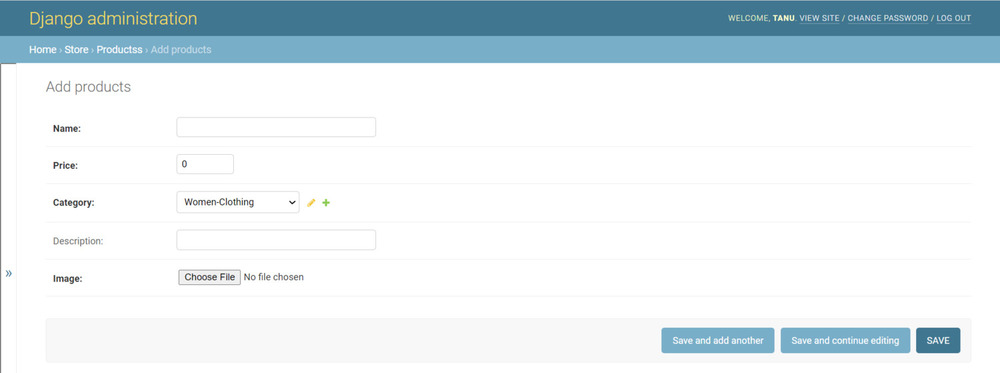
订单.py
Python
from django.db import models
from .product import Products
from .customer import Customer
import datetime
class Order(models.Model):
product = models.ForeignKey(Products,
on_delete=models.CASCADE)
customer = models.ForeignKey(Customer,
on_delete=models.CASCADE)
quantity = models.IntegerField(default=1)
price = models.IntegerField()
address = models.CharField(max_length=50, default='', blank=True)
phone = models.CharField(max_length=50, default='', blank=True)
date = models.DateField(default=datetime.datetime.today)
status = models.BooleanField(default=False)
def placeOrder(self):
self.save()
@staticmethod
def get_orders_by_customer(customer_id):
return Order.objects.filter(customer=customer_id).order_by('-date')
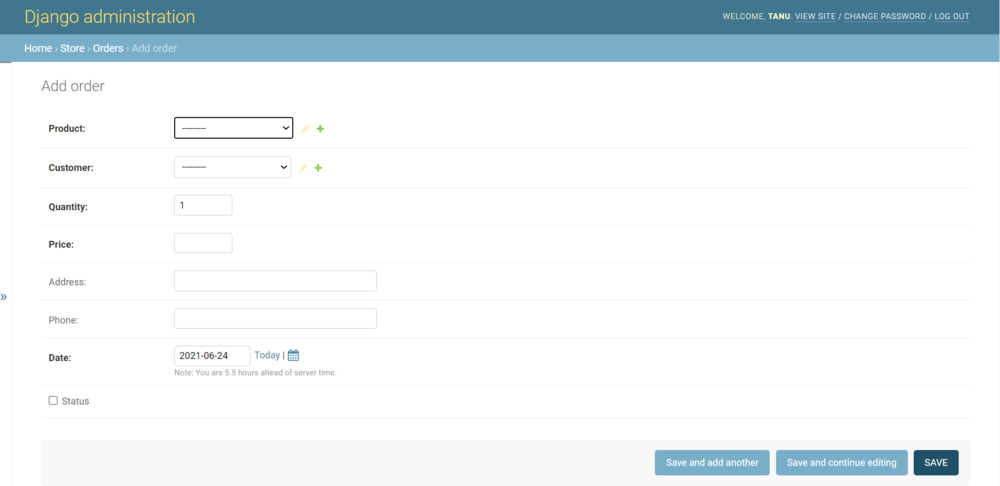
意见:
在视图中,我们创建一个名为home.py、login.py、signup.py、cart.py、checkout.py、orders.py 的视图,它接受请求并呈现 HTML 作为响应。在模板中创建home.html、login.html、signup.html、cart.html、checkout.html、orders.html 。并将视图映射到 store\urls.py 文件夹。
蟒蛇3
from django.contrib import admin
from django.urls import path
from .views.home import Index, store
from .views.signup import Signup
from .views.login import Login, logout
from .views.cart import Cart
from .views.checkout import CheckOut
from .views.orders import OrderView
from .middlewares.auth import auth_middleware
urlpatterns = [
path('', Index.as_view(), name='homepage'),
path('store', store, name='store'),
path('signup', Signup.as_view(), name='signup'),
path('login', Login.as_view(), name='login'),
path('logout', logout, name='logout'),
path('cart', auth_middleware(Cart.as_view()), name='cart'),
path('check-out', CheckOut.as_view(), name='checkout'),
path('orders', auth_middleware(OrderView.as_view()), name='orders'),
]
以下文件显示了站点每个功能的视图。
家.py
蟒蛇3
from django.shortcuts import render, redirect, HttpResponseRedirect
from store.models.product import Products
from store.models.category import Category
from django.views import View
# Create your views here.
class Index(View):
def post(self, request):
product = request.POST.get('product')
remove = request.POST.get('remove')
cart = request.session.get('cart')
if cart:
quantity = cart.get(product)
if quantity:
if remove:
if quantity <= 1:
cart.pop(product)
else:
cart[product] = quantity-1
else:
cart[product] = quantity+1
else:
cart[product] = 1
else:
cart = {}
cart[product] = 1
request.session['cart'] = cart
print('cart', request.session['cart'])
return redirect('homepage')
def get(self, request):
# print()
return HttpResponseRedirect(f'/store{request.get_full_path()[1:]}')
def store(request):
cart = request.session.get('cart')
if not cart:
request.session['cart'] = {}
products = None
categories = Category.get_all_categories()
categoryID = request.GET.get('category')
if categoryID:
products = Products.get_all_products_by_categoryid(categoryID)
else:
products = Products.get_all_products()
data = {}
data['products'] = products
data['categories'] = categories
print('you are : ', request.session.get('email'))
return render(request, 'index.html', data)
登录.py
蟒蛇3
from django.shortcuts import render, redirect, HttpResponseRedirect
from django.contrib.auth.hashers import check_password
from store.models.customer import Customer
from django.views import View
class Login(View):
return_url = None
def get(self, request):
Login.return_url = request.GET.get('return_url')
return render(request, 'login.html')
def post(self, request):
email = request.POST.get('email')
password = request.POST.get('password')
customer = Customer.get_customer_by_email(email)
error_message = None
if customer:
flag = check_password(password, customer.password)
if flag:
request.session['customer'] = customer.id
if Login.return_url:
return HttpResponseRedirect(Login.return_url)
else:
Login.return_url = None
return redirect('homepage')
else:
error_message = 'Invalid !!'
else:
error_message = 'Invalid !!'
print(email, password)
return render(request, 'login.html', {'error': error_message})
def logout(request):
request.session.clear()
return redirect('login')
注册.py
蟒蛇3
from django.shortcuts import render, redirect
from django.contrib.auth.hashers import make_password
from store.models.customer import Customer
from django.views import View
class Signup (View):
def get(self, request):
return render(request, 'signup.html')
def post(self, request):
postData = request.POST
first_name = postData.get('firstname')
last_name = postData.get('lastname')
phone = postData.get('phone')
email = postData.get('email')
password = postData.get('password')
# validation
value = {
'first_name': first_name,
'last_name': last_name,
'phone': phone,
'email': email
}
error_message = None
customer = Customer(first_name=first_name,
last_name=last_name,
phone=phone,
email=email,
password=password)
error_message = self.validateCustomer(customer)
if not error_message:
print(first_name, last_name, phone, email, password)
customer.password = make_password(customer.password)
customer.register()
return redirect('homepage')
else:
data = {
'error': error_message,
'values': value
}
return render(request, 'signup.html', data)
def validateCustomer(self, customer):
error_message = None
if (not customer.first_name):
error_message = "Please Enter your First Name !!"
elif len(customer.first_name) < 3:
error_message = 'First Name must be 3 char long or more'
elif not customer.last_name:
error_message = 'Please Enter your Last Name'
elif len(customer.last_name) < 3:
error_message = 'Last Name must be 3 char long or more'
elif not customer.phone:
error_message = 'Enter your Phone Number'
elif len(customer.phone) < 10:
error_message = 'Phone Number must be 10 char Long'
elif len(customer.password) < 5:
error_message = 'Password must be 5 char long'
elif len(customer.email) < 5:
error_message = 'Email must be 5 char long'
elif customer.isExists():
error_message = 'Email Address Already Registered..'
# saving
return error_message
购物车.py
蟒蛇3
from django.db import models
from .product import Products
from .customer import Customer
import datetime
class Order(models.Model):
product = models.ForeignKey(Products,
on_delete=models.CASCADE)
customer = models.ForeignKey(Customer,
on_delete=models.CASCADE)
quantity = models.IntegerField(default=1)
price = models.IntegerField()
address = models.CharField(max_length=50, default='', blank=True)
phone = models.CharField(max_length=50, default='', blank=True)
date = models.DateField(default=datetime.datetime.today)
status = models.BooleanField(default=False)
def placeOrder(self):
self.save()
@staticmethod
def get_orders_by_customer(customer_id):
return Order.objects.filter(customer=customer_id).order_by('-date')
结帐.py
蟒蛇3
from django.shortcuts import render, redirect
from django.contrib.auth.hashers import check_password
from store.models.customer import Customer
from django.views import View
from store.models.product import Products
from store.models.orders import Order
class CheckOut(View):
def post(self, request):
address = request.POST.get('address')
phone = request.POST.get('phone')
customer = request.session.get('customer')
cart = request.session.get('cart')
products = Products.get_products_by_id(list(cart.keys()))
print(address, phone, customer, cart, products)
for product in products:
print(cart.get(str(product.id)))
order = Order(customer=Customer(id=customer),
product=product,
price=product.price,
address=address,
phone=phone,
quantity=cart.get(str(product.id)))
order.save()
request.session['cart'] = {}
return redirect('cart')
订单.py
蟒蛇3
from django.shortcuts import render, redirect
from django.contrib.auth.hashers import check_password
from store.models.customer import Customer
from django.views import View
from store.models.product import Products
from store.models.orders import Order
from store.middlewares.auth import auth_middleware
class OrderView(View):
def get(self, request):
customer = request.session.get('customer')
orders = Order.get_orders_by_customer(customer)
print(orders)
return render(request, 'orders.html', {'orders': orders})
输出
该项目已经包含了很多功能。主要受益者是需要更长时间在线行为的客户和管理员。此外,可以在未来识别和合并其他功能。了解需求并将其调整为计算机化系统以适应附加功能需要更多的时间和精力。
GitHub 项目链接